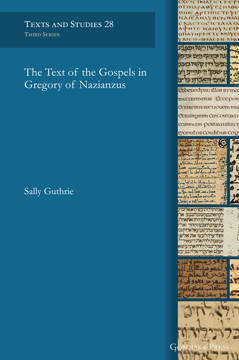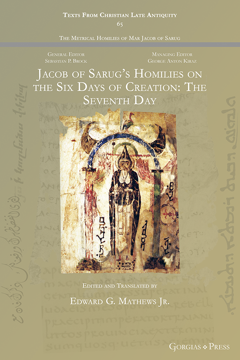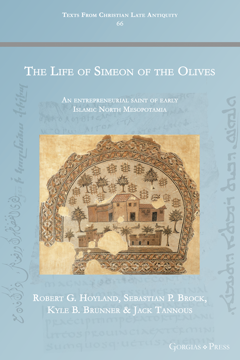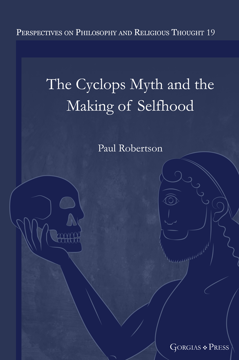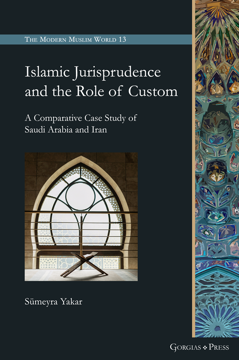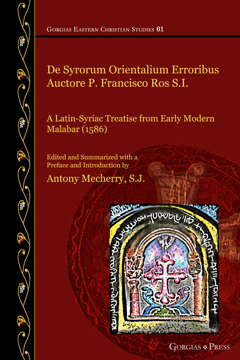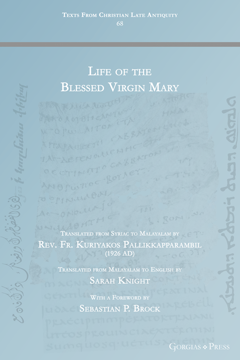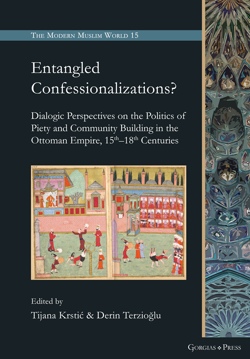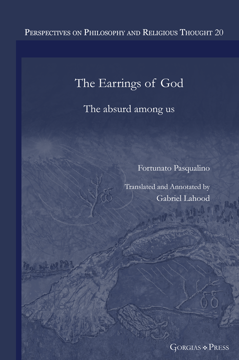The Text of the Gospels in Gregory of Nazianzus
Series: Texts and Studies (Third Series) 28
ISBN: 978-1-4632-4337-1
Quotations in early Christian writers provide important evidence for the text of the New Testament as well as the ways in which Scripture was used and received in the early Church. The fourth-century archbishop Gregory of Nazianzus was one of the most influential and widely-read authors of his time, but because the majority of his output was in poetic form he has rarely been treated as a source for the biblical text. The present study brings together all the identifiable references to the Gospels in Gregory’s writings for the first time, comparing them with standard biblical texts and manuscripts in order to determine their significance for the history and transmission of the New Testament. This collection also sheds new light on Gregory’s treatment of Scripture and the distinctive role it plays in his rhetorical style.
$149.00 (USD) $89.40 (USD)
New Perspectives on Ancient Nubia
Edited by Solange Ashby & Aaron J. Brody
Series: Gorgias Studies in the Ancient Near East 17
ISBN: 978-1-4632-4342-5
Ancient Nubia played key political, social, and economic roles in the ancient world, yet knowledge of Nubian societies remains regrettably narrow, with Nubia often disregarded as derivative of Egypt. This volume provides a timely corrective to this outlook, centering Nubian history and archaeology and presenting research from new, anti-racist perspectives. In addition to demonstrating Nubiology’s potential impact on Egyptological, classical, and biblical scholarship, this volume offers a new window into African achievements and dominance in the ancient world.
$114.95 (USD) $68.97 (USD)
Jacob of Sarug’s Homilies on the Six Days of Creation (The Seventh Day)
The Seventh Day
Edited and Translated by Edward G Mathews Jr
Series: Texts from Christian Late Antiquity 65
ISBN: 978-1-4632-4344-9
In this final installment of the long Homily 71, On the Six Days of Creation, Jacob treats the events of the seventh day.
$28.00 (USD) $16.80 (USD)
The Life of Simeon of the Olives
An entrepreneurial saint of early Islamic North Mesopotamia
Series: Texts from Christian Late Antiquity 66
ISBN: 978-1-4632-4346-3
The first ever critical edition and complete translation of the Syriac Life of Saint Simeon of the Olives, who was an abbot of Qartmin Monastery in Tur Abdin and a bishop of the city of Harran in the late seventh and early eighth century AD.
$50.00 (USD) $30.00 (USD)
The Cyclops Myth and the Making of Selfhood
ISBN: 978-1-4632-4348-7
This book explores the myth of the Cyclops across western history, and how its changing form from ancient Greece until the modern day reveals fundamental changes in each era’s elite understandings and depictions of cultural values. From Homer’s Odyssey to Hellenistic poetry, from Roman epic to early medieval manuscript glosses, and from early modern opera to current pop culture, the myth of the Cyclops persists in changing forms. This myth’s distinct forms in each historical era reflect and distill wider changes occurring in the spheres of politics, philosophy, aesthetics, and social values, and as a story that persists continually across three millennia it provides a unique lens for cross-historical comparison across western thought.
$114.95 (USD) $68.97 (USD)
Islamic Jurisprudence and the Role of Custom
A Comparative Case Study of Saudi Arabia and Iran
Series: Gorgias's Modern Muslim World 13
ISBN: 978-1-4632-4351-7
This volume examines approaches adopted by contemporary Hanbali and Jaʿfari scholars toward the sharʿī status of ʿurf in three categories: the methodological perspective (classic and contemporary), the nonbinding opinions of legal scholars (fatāwā), and the court verdicts of judges (aḥkām). The interaction between custom and textual authority is emphasized, developing an analytical framework of legal rules that pertain to social relations in general and marital issues in particular.
$120.00 (USD) $72.00 (USD)
De Syrorum Orientalium Erroribus, Auctore P. Francisco Ros S.I.
A Latin-Syriac Treatise from Early Modern Malabar (1586)
Edited and Summarized with a Preface and Introduction by Antony Mecherry, S.J.
Series: Gorgias Eastern Christian Studies 61
ISBN: 978-1-4632-4353-1
In the present work, De Syrorum Orientalium Erroribus, Auctore P. Francisco Ros S.I.: A Latin-Syriac Treatise from Early Modern Malabar (1586), Antony Mecherry S.J. brings to the fore a recently identified sixteenth-century treatise on ‘Nestorianism’ written by Francisco Ros S.J. (1559–1624), a Catalonian from the Jesuit province of Aragón, who successfully promoted the mission praxis of accommodatio primarily among the Saint Thomas Christians of early modern Malabar in South India. This newly discovered first treatise composed by Ros, a Latin missionary, represents the initial phase of his mission as a polemicist in the making, who read the Syriac sources of the Church of the East found in Malabar, through a Catholic theological lens. In addition to exploring the underlying conflicts emerged out of an unprecedented encounter of apparently unlike theological and liturgical identities in the same mission field of early modern India, this book provides the readers with a historiographical critique against the backdrop of which the author presents his analysis of the Rosian treatise.
$55.00 (USD) $33.00 (USD)
Life of the Blessed Virgin Mary
Translated from Syriac to Malayalam by Rev. Fr. Kuriyakos Pallikkapparambil (1926 AD); Translated from Malayalam to English by Sarah Knight; With a Foreword by Sebastian P. Brock
Series: Texts from Christian Late Antiquity 68
ISBN: 978-1-4632-4355-5
Different parts of the Life of the Blessed Virgin Mary are known from the second century onwards. Translations and adaptations into Syriac and other languages also became available from very early centuries. The compilation in the Syriac language was translated into Malayalam in 1925, but an English translation containing the full text did not exist at all. This gap has been filled now by this work. Sebastian Brock’s Foreword gives important information on the background and authenticity of the different sources that form the basis of the text. This biography is unique in that it brings together some very early accounts of the birth of Mary, the birth of Jesus, the flight into Egypt, and most importantly, the very rare account of the ‘Dormition’ or ‘falling asleep’ of the Blessed Mother.
$55.00 (USD) $33.00 (USD)
Entangled Confessionalizations?
Dialogic Perspectives on the Politics of Piety and Community Building in the Ottoman Empire, 15th-18th Centuries
Edited by Tijana Krstić & Derin Terzioğlu
Series: Gorgias's Modern Muslim World 15
ISBN: 978-1-4632-4357-9
This volume explores the emergence of discourses of orthodoxy and orthopraxy in the Ottoman Empire between the 15th and 18th centuries, through empirical studies on confessional dynamics in early modern Muslim, Christian and Jewish sources.
$195.00 (USD) $117.00 (USD)
The Earrings of God
The absurd among us
By Fortunato Pasqualino; Translated and Annotated by Gabriel Lahood
ISBN: 978-1-4632-4359-3
Life is full of absurdities, and human misperception of such absurdities leads to a state of unrest and fear that require meaning and direction for a happy life. F. Pasqualino addresses here samples of existential absurdities, and discusses solutions offered: Taoism offers in its paradoxes a natural self-help resource. Buddhism offers a natural wisdom that is informed by a supernatural impersonal Absolute. Hinduism offers a plethora of personal gods who embody the impersonal Absolute. The Judeo-Christian-Islamic wisdom teaches a personal Absolute God whose being is distinct from, but involved with human and non-human beings. The unifying feature of these wisdoms is: Obedience to, and love of, the Absolute can rectify human misperception of life’s absurdities, dissipate fear, and provide meaning, value and a serene life. Jesus Christ, the incarnate Absolute in Christian theology, chose to become an exemplar innocent victim for love, thus giving the most absurd but victoriously redeeming love that provides a new and sublime perspective on life’s absurdities. G. Lahood’s translation and commentary make the Italian masterpiece available to an English-speaking audience.
$123.95 (USD) $74.37 (USD)
